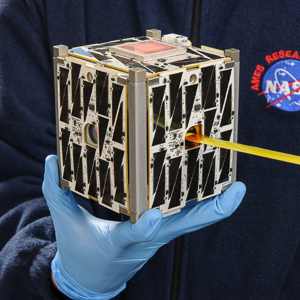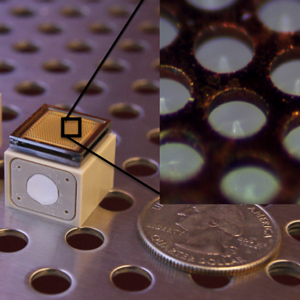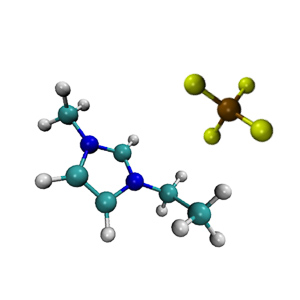Ion Electrospray Propulsion
Micropropulsion is a new and exciting field within the rocket propulsion technologies umbrella. A microthruster typically produces microNewton levels of thrust, which is comparable to the weight of a sesame seed! This may not sound particularly useful, but for applications such as CubeSat propulsion, microthrusters are in great demand. Since the late 1990s, it has become possible to scale down the vast majority of spacecraft subsystems by several orders of magnitude. As a result, it is now possible to build satellites small enough to be held by human hands! CubeSats are essentially the Legos of microsatellite design and are constructed from standardized 10 cm cubes. Mature propulsion technologies such as chemical rockets or plasma thrusters (eg. Kaufman ion thrusters, Hall Effect thrusters) are well-suited for large spacecraft (mass > 1000 kg). However, scaling these technologies down to CubeSat-compatible sizes results in significant efficiency losses and reduced lifetime. There is now a wide technology gap, which has propelled the field of micropropulsion to the fore-front of in-space propulsion research. New propulsion technologies are now being developed at universities, research labs, and companies around the world - it's an exciting time to be a rocket scientist!
Ion electrospray propulsion is a micropropulsion technology under development at the MIT Space Propulsion Lab (SPL). Ion electrospray thrusters use ionic liquids as propellant, which are molten salts at room temperature that consist entirely of positive and negative molecular, and sometimes atomic, ions. Strong electric fields can be used to evaporate ions from the liquid and accelerate them to high velocities. Ion electrospray thrusters can be created by laser-etching hundreds of emitter tips into a porous material. The ionic liquid propellant soaks into the pores and is transported to the tip of each emitter via capillary action. A MEMS-fabricated metal extractor plate with one aperture for each tip is placed above the emitter array. Approximately 1 kV of electric potential is applied between the emitter array and extractor plate, which creates extremely strong electric fields at the emitter tips. Ions are evaporated from each tip and are accelerated through the apertures in the extractor. SPL thruster designs can pack 480 emitter tips in a 1 cm2 area. These thrusters can produce 12 microNewtons of thrust with a specific impulse exceeding 1200 seconds. The power required to operate a single thruster is on the order of one hundred milliWatts.
For my Ph.D. thesis, I investigated aspects of the fundamental physics behind the electrospray technology. Ion electrospray thrusters produce ion beams that consist of single ions as well as clusters of positive and negative ions. The ion clusters are not stable and can break apart while they are being accelerated within the thruster. Ion cluster dissociation, sometimes referred to as fragmentation, decreases the thruster efficiency and specific impulse. Prior to my work, fragmentation was not a well-understood process, which motivated further experimental study. I designed and built a specialized set of instruments to thoroughly characterize ion cluster dissociation in ion electrospray thrusters. My results support the hypothesis that fragmentation can be described as an activated process and that, in the absence of an external electric field, a population of ion clusters of a particular type, with uniform internal temperature, dissociates at a constant rate. I was also able to estimate the initial average internal temperature of the ion clusters and how much energy they gain during the evaporation process. Additionally, I found that the stability of the ion clusters is related to the molecular structure of the individual anions and cations that make up the ionic liquid. Ion clusters based on large molecular ions, those composed of many atoms, tend to dissociate more slowly than clusters composed of simple molecular ions. Further work in this area is required to determine the initial temperature distribution of the ion clusters and to characterize the effect that an external electric field has on the dissociation rates.



Publications
Characterization of Ion Cluster Dissociation in Ion Electrospray Thrusters Using
Time of Flight Mass Spectrometry
Miller, C., (2022). 37th International Electric Propulsion Conference, Boston, MA.
Retarding Potential Analyzer: Principles, Designs, and Space Applications
Lai, S., and Miller, C., (2020). AIP Advances, 10, 095324.
Measurement of the Dissociation Rates of Ion Clusters in Ionic Liquid Ion Sources
Miller, C., and Lozano, P., (2020). Applied Physics Letters, 116, 254101.
Development of an Electrospray Source Model for Kinetic Plume Modeling
Petro, E., Miller, C., Schmidt, J., and Lozano, P. (2019). 36th International Electric Propulsion Conference, Vienna, Austria.
Characterization of Ion Cluster Fragmentation in Ionic Liquid Ion Sources
Miller, C., (June 2019). Doctoral Thesis, Massachusetts Institute of Technology.
Experimental Measurements of an AF-M315E-fed ion Electrospray Propulsion System (iEPS)
Miller, C., Lozano, P., Polzin, K., (2018). 65th JANNAF Propulsion Conference, Long Beach, CA.
Characterization of EMI-(HF)2.3F Using Carbon Xerogel Electrospray Thrusters
Miller, C., Bates, C., Getty, D., and Lozano, P., (2017). 35th International Electric Propulsion Conference, Atlanta, GA.
Measurement of the Fragmentation Rates of Solvated Ions in Ion Electrospray Thrusters
Miller, C., and Lozano, P., (July 2016). 52nd AIAA/SAE/ASEE Joint Propulsion Conference, Salt Lake City, UT.
Efficiency Effects of Metastable Complex Ions in Electrospray Ion Thrusters
Miller, C., and Lozano, P., (July 2015). 34th International Electric Propulsion Conference, Kobe, Hyogo, Japan.
On the Stability of Complex Ions in Ionic Liquid Ion Sources
Miller, C., (May 2015). Master’s Thesis, Massachusetts Institute of Technology.